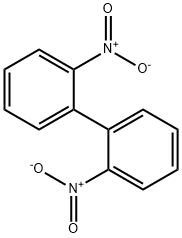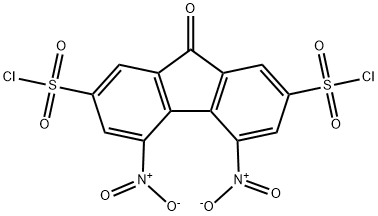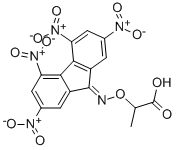2,2'-DINITROBIPHENYL
- CAS NO.:2436-96-6
- Empirical Formula: C12H8N2O4
- Molecular Weight: 244.2
- MDL number: MFCD00007127
- EINECS: 219-435-4
- SAFETY DATA SHEET (SDS)
- Update Date: 2023-04-23 13:52:06

What is 2,2'-DINITROBIPHENYL?
Chemical properties
light yellow to beige crystalline powder
The Uses of 2,2'-DINITROBIPHENYL
2,2?-Dinitrobiphenyl has been used as an internal standard in the determination of p,p?-DDT in technical and formulated products using gas chromatographic method
The Uses of 2,2'-DINITROBIPHENYL
2,2′-Dinitrobiphenyl has been used as an internal standard in the determination of p,p′-DDT in technical and formulated products using gas chromatographic method.
Definition
ChEBI: Biphenyl substituted with nitro groups at the 2- and 2'-positions.
Synthesis Reference(s)
Organic Syntheses, Coll. Vol. 3, p. 339, 1955
The Journal of Organic Chemistry, 53, p. 4482, 1988 DOI: 10.1021/jo00254a012
Tetrahedron Letters, 16, p. 143, 1975
General Description
The electroreduction of 2,2′-dinitrobiphenyl in anionic, cationic, and nonionic micellar solutions has been studied by polarography and cyclic voltammetry.
Purification Methods
Crystallise the biphenyl from EtOH, AcOH (m 124.5o) or pet ether (m 125.5-126o). [Beilstein 5 H 538, 5 III 1759, 5 IV 1826.]
Properties of 2,2'-DINITROBIPHENYL
| Melting point: | 124-126 °C(lit.) |
| Boiling point: | 305°C |
| Density | 1,45 g/cm3 |
| refractive index | 1.6360 (estimate) |
| Flash point: | 305°C |
| storage temp. | Sealed in dry,2-8°C |
| form | powder to crystal |
| color | White to Light yellow |
| Water Solubility | Insoluble in water |
| BRN | 1579851 |
| CAS DataBase Reference | 2436-96-6(CAS DataBase Reference) |
Safety information for 2,2'-DINITROBIPHENYL
| Signal word | Warning |
| Pictogram(s) |
 Exclamation Mark Irritant GHS07 |
| GHS Hazard Statements |
H315:Skin corrosion/irritation H319:Serious eye damage/eye irritation H335:Specific target organ toxicity, single exposure;Respiratory tract irritation |
| Precautionary Statement Codes |
P261:Avoid breathing dust/fume/gas/mist/vapours/spray. P264:Wash hands thoroughly after handling. P264:Wash skin thouroughly after handling. P270:Do not eat, drink or smoke when using this product. P271:Use only outdoors or in a well-ventilated area. P280:Wear protective gloves/protective clothing/eye protection/face protection. P304+P340:IF INHALED: Remove victim to fresh air and Keep at rest in a position comfortable for breathing. P305+P351+P338:IF IN EYES: Rinse cautiously with water for several minutes. Remove contact lenses, if present and easy to do. Continuerinsing. P405:Store locked up. P501:Dispose of contents/container to..… |
Computed Descriptors for 2,2'-DINITROBIPHENYL
New Products
4-Fluorophenylacetic acid 4-Methylphenylacetic acid N-Boc-D-alaninol N-BOC-D/L-ALANINOL Tert-butyl bis(2-chloroethyl)carbamate 3-Morpholino-1-(4-nitrophenyl)-5,6-dihydropyridin- 2(1H)-one Furan-2,5-Dicarboxylic Acid Tropic acid S-2-CHLORO PROPIONIC ACID ETHYL ISOCYANOACETATE 2-Bromo-1,3-Bis(Dimethylamino)Trimethinium Hexafluorophosphate (6-METHYL-[1,3]DITHIOLO[4,5-b]QUINOXALIN-2-ONE INDAZOLE-3-CARBOXYLIC ACID 4-IODO BENZOIC ACID (2-Hydroxyphenyl)acetonitrile 4-Bromopyrazole 5,6-Dimethoxyindanone 2-(Cyanocyclohexyl)acetic acid 4-methoxy-3,5-dinitropyridine 2-aminopropyl benzoate hydrochloride 1-(4-(aminomethyl)benzyl)urea hydrochloride diethyl 2-(2-((tertbutoxycarbonyl)amino) ethyl)malonate tert-butyl 4- (ureidomethyl)benzylcarbamate Ethyl-2-chloro((4-methoxyphenyl)hydrazono)acetateRelated products of tetrahydrofuran

![9-[4-(HEXYLOXY)BENZYLIDENE]-2,4,5,7-TETRANITRO-9H-FLUORENE](https://img.chemicalbook.in/StructureFile/ChemBookStructure2/GIF/CB4490430.gif)

![N,N-DIMETHYL-N-[(2,4,5,7-TETRANITRO-9H-FLUOREN-9-YLIDEN)METHYL]AMINE](https://img.chemicalbook.in/StructureFile/ChemBookStructure2/GIF/CB2730798.gif)




You may like
-
 2,2'-Dinitrobiphenyl CAS 2436-96-6View Details
2,2'-Dinitrobiphenyl CAS 2436-96-6View Details
2436-96-6 -
 2033-24-1 98%View Details
2033-24-1 98%View Details
2033-24-1 -
 1975-50-4 98%View Details
1975-50-4 98%View Details
1975-50-4 -
 2-HYDROXY BENZYL ALCOHOL 98%View Details
2-HYDROXY BENZYL ALCOHOL 98%View Details
90-01-7 -
 2-Chloro-1,3-Bis(Dimethylamino)Trimethinium Hexafluorophosphate 221615-75-4 98%View Details
2-Chloro-1,3-Bis(Dimethylamino)Trimethinium Hexafluorophosphate 221615-75-4 98%View Details
221615-75-4 -
 61397-56-6 CIS BROMO BENZOATE 98%View Details
61397-56-6 CIS BROMO BENZOATE 98%View Details
61397-56-6 -
 14714-50-2 (2-Hydroxyphenyl)acetonitrile 98+View Details
14714-50-2 (2-Hydroxyphenyl)acetonitrile 98+View Details
14714-50-2 -
 118753-70-1 98+View Details
118753-70-1 98+View Details
118753-70-1